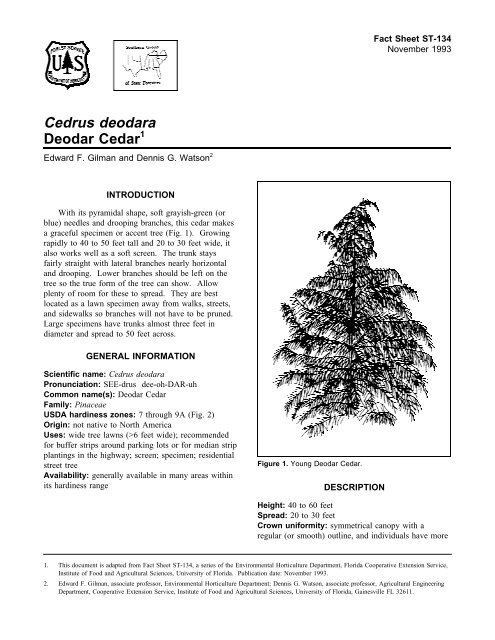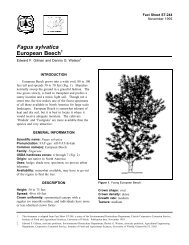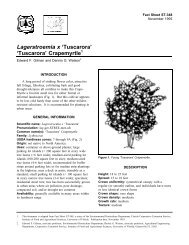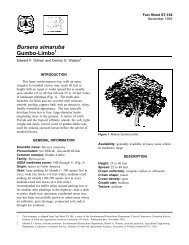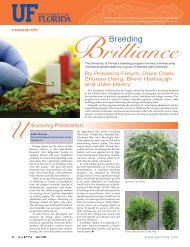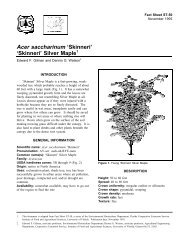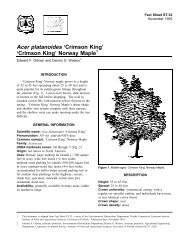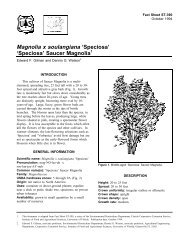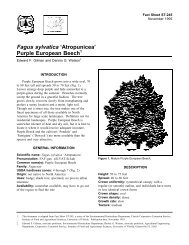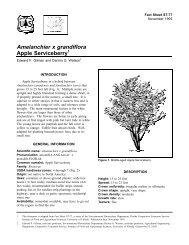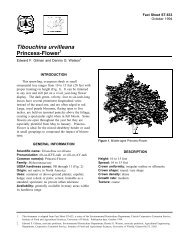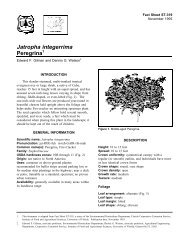Cedrus deodara Deodar Cedar - Environmental Horticulture ...
Cedrus deodara Deodar Cedar - Environmental Horticulture ...
Cedrus deodara Deodar Cedar - Environmental Horticulture ...
Create successful ePaper yourself
Turn your PDF publications into a flip-book with our unique Google optimized e-Paper software.
<strong>Cedrus</strong> <strong>deodara</strong><br />
<strong>Deodar</strong> <strong>Cedar</strong> 1<br />
Edward F. Gilman and Dennis G. Watson 2<br />
INTRODUCTION<br />
With its pyramidal shape, soft grayish-green (or<br />
blue) needles and drooping branches, this cedar makes<br />
a graceful specimen or accent tree (Fig. 1). Growing<br />
rapidly to 40 to 50 feet tall and 20 to 30 feet wide, it<br />
also works well as a soft screen. The trunk stays<br />
fairly straight with lateral branches nearly horizontal<br />
and drooping. Lower branches should be left on the<br />
tree so the true form of the tree can show. Allow<br />
plenty of room for these to spread. They are best<br />
located as a lawn specimen away from walks, streets,<br />
and sidewalks so branches will not have to be pruned.<br />
Large specimens have trunks almost three feet in<br />
diameter and spread to 50 feet across.<br />
GENERAL INFORMATION<br />
Scientific name: <strong>Cedrus</strong> <strong>deodara</strong><br />
Pronunciation: SEE-drus dee-oh-DAR-uh<br />
Common name(s): <strong>Deodar</strong> <strong>Cedar</strong><br />
Family: Pinaceae<br />
USDA hardiness zones: 7 through 9A (Fig. 2)<br />
Origin: not native to North America<br />
Uses: wide tree lawns (>6 feet wide); recommended<br />
for buffer strips around parking lots or for median strip<br />
plantings in the highway; screen; specimen; residential<br />
street tree<br />
Figure 1. Young <strong>Deodar</strong> <strong>Cedar</strong>.<br />
Availability: generally available in many areas within<br />
its hardiness range DESCRIPTION<br />
Fact Sheet ST-134<br />
November 1993<br />
Height: 40 to 60 feet<br />
Spread: 20 to 30 feet<br />
Crown uniformity: symmetrical canopy with a<br />
regular (or smooth) outline, and individuals have more<br />
1. This document is adapted from Fact Sheet ST-134, a series of the <strong>Environmental</strong> <strong>Horticulture</strong> Department, Florida Cooperative Extension Service,<br />
Institute of Food and Agricultural Sciences, University of Florida. Publication date: November 1993.<br />
2. Edward F. Gilman, associate professor, <strong>Environmental</strong> <strong>Horticulture</strong> Department; Dennis G. Watson, associate professor, Agricultural Engineering<br />
Department, Cooperative Extension Service, Institute of Food and Agricultural Sciences, University of Florida, Gainesville FL 32611.
<strong>Cedrus</strong> <strong>deodara</strong> -- <strong>Deodar</strong> <strong>Cedar</strong> Page 2<br />
Figure 2. Shaded area represents potential planting range.<br />
or less identical crown forms<br />
Crown shape: pyramidal<br />
Crown density: moderate<br />
Growth rate: fast<br />
Texture: fine<br />
Foliage<br />
Leaf arrangement: spiral (Fig. 3)<br />
Leaf type: simple<br />
Leaf margin: entire<br />
Leaf shape: needle-like (filiform)<br />
Leaf venation: parallel<br />
Leaf type and persistence: evergreen; needle leaf<br />
evergreen<br />
Leaf blade length: less than 2 inches<br />
Leaf color: green; silver<br />
Fall color: no fall color change<br />
Fall characteristic: not showy<br />
Flower<br />
Flower characteristics: inconspicuous and not<br />
showy; spring flowering<br />
Fruit<br />
Fruit shape: oval<br />
Fruit length: 3 to 6 inches<br />
Fruit covering: dry or hard<br />
Fruit color: brown<br />
Fruit characteristics: does not attract wildlife; no<br />
significant litter problem; persistent on the tree; showy<br />
Trunk and Branches<br />
Trunk/bark/branches: droop as the tree grows, and<br />
will require pruning for vehicular or pedestrian<br />
clearance beneath the canopy; not particularly showy;<br />
should be grown with a single leader; no thorns<br />
Pruning requirement: needs little pruning to develop<br />
a strong structure<br />
Breakage: resistant<br />
Current year twig color: brown; green<br />
Current year twig thickness: medium<br />
Culture<br />
Light requirement: tree grows in full sun<br />
Soil tolerances: clay; loam; sand; slightly alkaline;<br />
acidic; occasionally wet; well-drained
<strong>Cedrus</strong> <strong>deodara</strong> -- <strong>Deodar</strong> <strong>Cedar</strong> Page 3<br />
Figure 3. Foliage of <strong>Deodar</strong> <strong>Cedar</strong>.<br />
Drought tolerance: high<br />
Other<br />
Roots: surface roots are usually not a problem<br />
Winter interest: no special winter interest<br />
Outstanding tree: tree has outstanding ornamental<br />
features and could be planted more<br />
Invasive potential: little, if any, potential at this time<br />
Verticillium wilt susceptibility: not known to be<br />
susceptible<br />
Pest resistance: long-term health usually not<br />
affected by pests<br />
USE AND MANAGEMENT<br />
The tree has been successfully used as a street or<br />
median planting with lower branches removed. It<br />
appears to tolerate compacted, poor soil but declines in<br />
areas where smog is a problem. Plant on 20-footcenters<br />
to create a canopy of blue foliage over a small<br />
residential street. This is probably the best true cedar<br />
for the South.<br />
Transplants easily if root-pruned or from a<br />
container and protected from sweeping winds. It does<br />
well in dry, sunny spots and will tolerate high pH and<br />
clay soil. Cold-damaged trees die back at the top.<br />
There are numerous attractive cultivars. ‘Kashmir’<br />
has silvery foliage and is hardy in USDA hardiness<br />
zone 6; ‘Aurea’ has yellow leaves (looks ill);<br />
‘Pendula’ has long, drooping leaves; ‘Robusta’ has<br />
stiffer twigs.<br />
Pests and Diseases<br />
No pests or diseases are of major concern.<br />
Perhaps scales, borers, deodar weevils, and bagworms.<br />
Following a cold winter, tops often decline and<br />
dieback in USDA hardiness zone 7. Secondary fungi<br />
can sometimes be associated with this decline.


